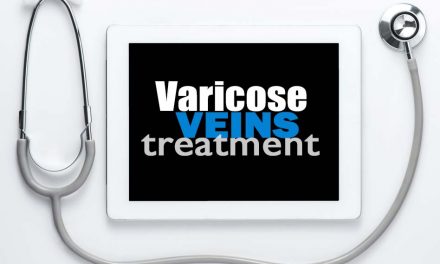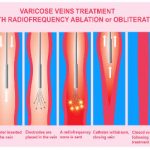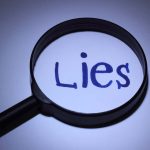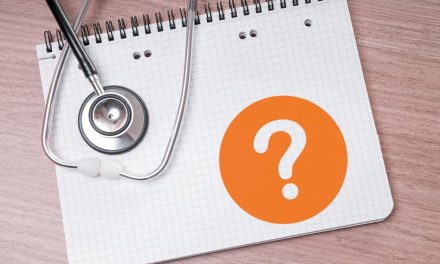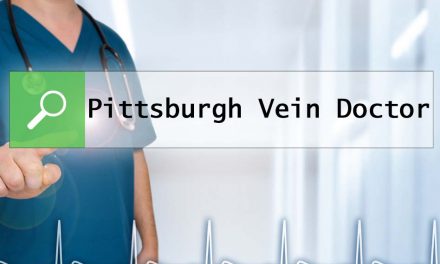
Radiofrequency vs. Laser for Saphenous Vein Ablations

The Quick Down-and-Dirty Answer to Laser vs. Radiofrequency for Saphenous Vein Treatment
For those who just need the quick answer and don’t have time to finish the entire article, there is no significant difference to which is best.
The latest generation of both lasers and radiofrequency closure devices have similar results and similar levels of discomfort after the treatment of varicose veins.
They are just alternative techniques to accomplish the same goal.
What is better to draw a straight line – a ruler or a yardstick? The final result is the same.
A straight line.
Right?
The latest available techniques in treating abnormal saphenous veins also result in virtually the same outcome.
A closed vein that is absorbed by your body.
The risks including burns, numbness, and failure to close the vein are essentially the same with each technique.
Nevertheless, it’s not that simple.
Vein doctors who have experience treating varicose veins have different personal opinions regarding radiofrequency ablation vs. laser ablation for varicose veins.
Different valid opinions can muddy the waters.
There is no clear-cut answer. That means they are about the same.
For those who want to learn more, perhaps the title of this article is not the right question.
Asking the right question is sometimes more important than the answer. Here are some famous quotes and examples of this concept.
“There are no right answers to wrong questions.” – Ursula K. Le Guin
“We thought that we had the answers, it was the questions we had wrong.” – Bono
“What people think of as the moment of discovery is really the discovery of the question.” – Jonas Salk
“The uncreative mind can spot wrong answers, but it takes a very creative mind to spot wrong questions.” – Antony Jay
“In school, we’re rewarded for having the answer, not for asking a good question.” – Richard Saul Wurman
“Judge a man by his questions rather than his answers.” – Voltaire
What Questions Should We Be Asking When Seeking Vein Treatments?
The better questions are:
- How much experience does the vein specialist have?
- How many procedures have they performed?
- What are the qualifications of the treating vein specialist?
- Is the entire vein center accredited or just their ultrasound department?
- Where should I have my varicose veins treated?
Instead of asking whether laser is better or radiofrequency is better for varicose veins, you should focus more on the varicose vein doctor and the varicose vein treatment center.
https://pittsburghveindoc.com/2015/04/08/varicose-vein-treatment-center/
Let’s Compare Laser and Radiofrequency
To compare the two modalities, you must be aware of the evolution of both of these technologies. This gradual change has occurred over the last 15 years since they were first FDA approved.
If you read an article from years ago, the success, results, complication rates, and the degree of pain described may not be accurate compared to the latest generation of that technology that is available today.
There are dozens of studies in the literature comparing the two technologies.
These articles are like looking at a single picture frame within an every changing movie.
Those reports represent the information that was available at that point in time.
It’s like comparing a Model T Ford to a Lamborghini. Or comparing the Wright brother’s plane to a stealth fighter jet.
Think about it.
The stealth jet and the Lamborghini are the latest incarnations of each mode of transportation but is one better than the other?
The vein specialist who operates either the laser or the Closure device determines the success or failure of the treatment. However, today with the latest designs of each of these technologies, failure rates are extremely low and very similar in experienced hands.
If an adequate amount of energy is not given with either method, the vein will not seal. The procedure would then need to be repeated. Sometimes after repeated failures, the vein may need to be removed surgically.
Therefore, both methods of closing the saphenous veins are equally effective in the right hands.
The more experienced your doctor is with the technology that he is comfortable with performing, the more successful the procedure will be. Also the more experienced your doctor is with either laser or radio frequency closure, the less risk there will be of a complication.
I perform both laser treatments and radiofrequency treatments on the saphenous veins depending on the patient’s anatomy and other circumstances. Here is the latest published data comparing laser vs. radiofrequency for the treatment of varicose veins.
What is Heck is Radiofrequency Closure?
VNUS® RF (radiofrequency) Ablation system (also called the Closure® procedure) is a vein treatment procedure that uses radiofrequency energy (electricity) to heat, collapse and seal off the targeted veins.
Radiofrequency depends on a principle called diathermy. Diathermy is just electrically induced heat. Since it is bipolar, the electrical current does not pass through your body, just through the catheter. A feedback mechanism in the fiber can change the energy that is delivered to sustain a consistent temperature range to the targeted vein.
Radiofrequency was FDA approved first in 1999. Initially, when radiofrequency was FDA approved, there were many problems.
When radiofrequency was first introduced, the end of the probe often clotted multiple times during the procedure.
It often became clogged from the clotted blood. It had to be withdrawn, cleaned and reinserted. This caused failures. The treated veins failed to close. This led to recurrences.
Failure rates were significantly higher than with the latest generation catheter.
In 2005, VNUS, the company that designed the radiofrequency method to treat veins, introduced a new design in the catheter used to apply the radiofrequency to the inside of the vein wall.
The latest generation of radiofrequency catheters is called ClosureFAST. It has a 7 cm long heating element at the end of the catheter.
Watch a YouTube video of how radiofrequency works to close the saphenous vein.
For the Closure FAST procedure, a radiofrequency generator controls the heating element at 120°C for a 20-second period. The radiofrequency catheter is shaped like a thin tube throughout its length.
The catheter is withdrawn 7 cm at a time. The early catheter was withdrawn from the vein typically at a rate of 2-4 centimeters per minute.
The catheter is fired for twenty seconds. The process is repeated over and over down the targeted vein. Usually the veins that are closed are the great or small saphenous veins.
In most cases, the actual varicose veins that you see under the skin are branches from these saphenous veins. The saphenous veins feed into your varicose veins.
These branches (varicose veins) cannot be closed with either radiofrequency or laser. Usually either sclerotherapy (injections) or phlebectomy (removal of the actual varicose veins through mini incisions) are necessary to clean up these remaining varicose veins themselves.
How Do Lasers Work to Seal Off Saphenous Veins?
The word, laser, stands for “Light Amplification by Stimulated Emission of Radiation.
The most commonly used lasers to treat saphenous veins are classified as diode lasers. Lasers also have generators. Different lasers use different wavelengths of light to burn or coagulate the inside of the targeted vein after the laser light has been amplified.
There are many different types of lasers that are used to close saphenous veins. Each has advantages and disadvantages. The lower wavelength vein lasers include the 810 nm, 940 nm, and 980 nm. These lasers target the hemoglobin in your blood.
Higher wavelength lasers target the water in the vein itself. These include the 1320 nm and 1470 nm lasers.
The higher wavelength lasers are believed to be less painful. However, the data is weak in this regard. Whether the higher wavelengths generate less energy accounting for less discomfort after the procedure is the question.
In addition, there are many different laser fiber designs. They can be divided into bare tippped fibers or coated fibers. The coated fibers do not burn through the wall of the vein as often as the bare tipped fibers. Coated fibers may cause less bruising and discomfort for that reason. Coated fibers are more expensive.
Evidence for one type of fiber being better than another is inconclusive.
How to Adjust for a Bigger Diameter Vein
With laser, the amount of energy in watts can be manually set. In addition, the speed of withdrawal of the laser fibers can be varied. For smaller veins, the withdrawal can be faster. For larger veins, the speed of withdrawal can be slowed. These two mechanisms of changing the amount of heat or energy can be fine-tuned by the vein specialist doing the laser procedure.
With radiofrequency, the generator continually adjusts the temperature by using constant feedback. Early versions of the radiofrequency catheters could not consistently close veins larger than 12 mm. However, later catheters do not have this restriction.
It should be noted that at the top of the saphenous veins, the pressures are the highest. Manufacturers of the radiofrequency catheters recommend that these segments should be treated twice to prevent the vein from opening up or not closing.
Treating larger veins tends to produce a higher failure rates. Morbid obesity causes more pressure in the saphenous veins.
These factors lead to an increased failure with both laser and radiofrequency.
What Choices Are Currently Available to Treat Abnormal Saphenous Veins?
For people seeking varicose vein treatment, the treatment choices can be confusing.
At this time, there are just two choices that are covered by insurance to close the saphenous veins. That is either laser or radiofrequency.
Both techniques are very similar.
There are minor differences.
Patient satisfaction and the resulting improved quality of life after these procedures are also very similar.
The saphenous veins can be viewed as the “root of the problem” for a patient with varicose veins. However, often more than just the saphenous vein needs to be treated to satisfy most patients and get long lasting results.
In about two to three years, there will be more options available to shut down the saphenous vein that will be covered by insurance.
These include:
- Glue
- Mechanico-chemical treatment
- Foam sclerotherapy (with a special foam called Varithena))
- Steam
- Cryotherapy
Although many of these treatments are available and most are FDA approved, insurance companies do not have a code to bill them yet. That makes it very difficult or impossible to bill your insurance company. Often these treatments run into the thousands of dollars if you choose to pay out of pocket.
Conclusion
What should you choose for your varicose vein procedure?
Perhaps that’s not the right question.
Should you even worry about laser or radiofrequency to treat your vein problems?
Both laser and radiofrequency technologies have evolved and improved since both they were first FDA approved.
If you read an article concluding that laser hurts more or there are higher complications with one mode of shutting down the saphenous vein vs. another, don’t believe it.
Consider the year that the article was written when comparing the two methods.
Have those technologies improved since that date?
Laser technology has changed from targeting blood to targeting the water in the vein to close it.
Laser fibers have also evolved. The fibers used to be bare at the tip. Now there are laser fibers that are coated at the tip which disperse their energy more evenly.
With these changes, laser is no longer more painful than radiofrequency.
Radiofrequency has evolved from a catheter that was slow and clogged repeatedly to a catheter that generates energy through a 7 cm length.
This latest generation of radiofrequency catheter is more consistent in successfully closing the targeted vein.
In conclusion, instead of asking laser vs. radiofrequency to treat your varicose veins, choose a laser center based on the doctor’s qualifications, experience, and the accreditation of the vein center.
Asking the right question, leads to better solutions.
Ask us your questions. Call to learn more at 724-987-3220.


